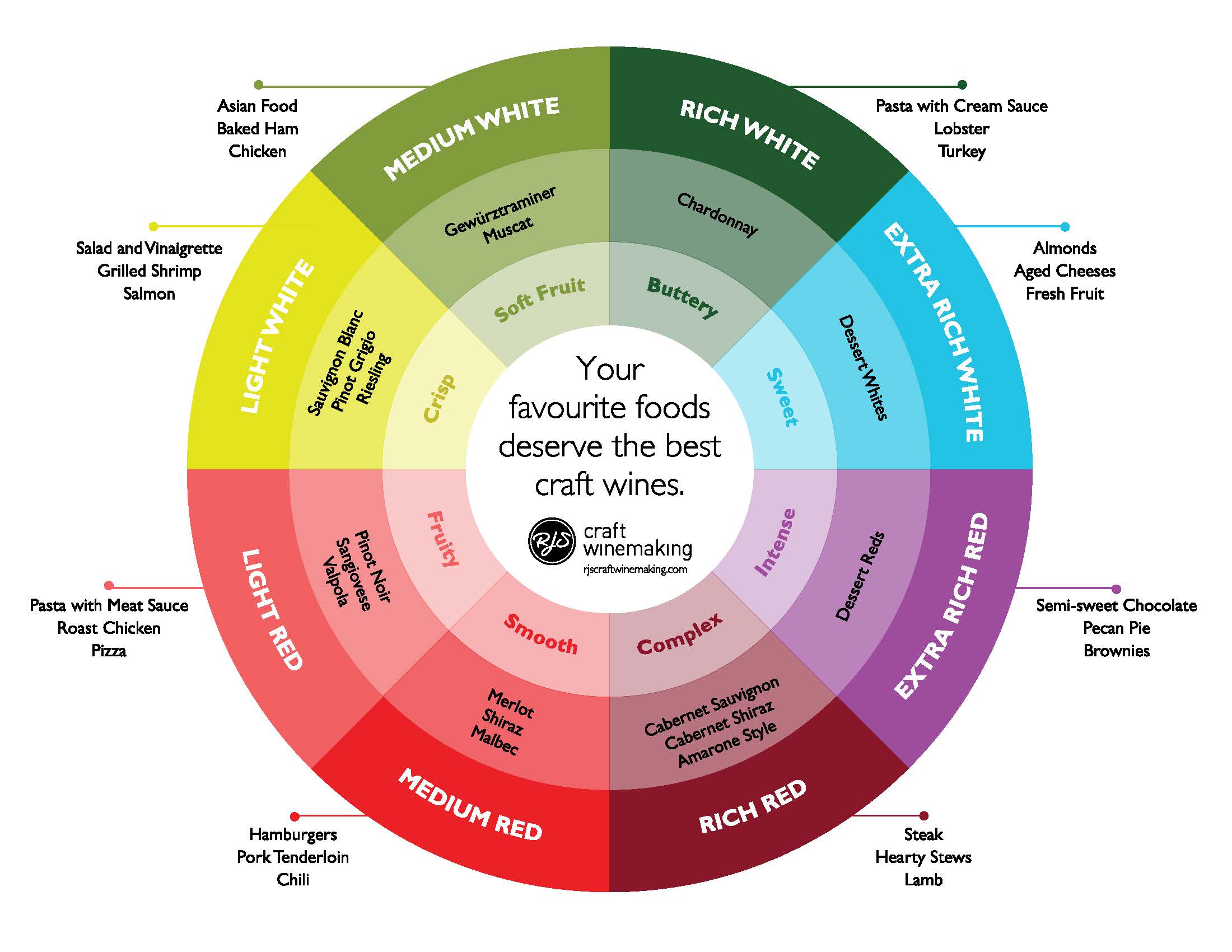Wine & Food Pairing
The easiest way to pair wine with food is to take your wine and look it up on the table below. Each type of wine listed has a general flavor profile and works with different foods. The table is fairly simple, but it works and can be expanded to cover more foods and wines as you become more familiar with your palate.
|
Type |
Profile |
Example Wines |
Suggested Food Pairings |
|
Light White |
Crisp |
Sauvignon Blanc Pinot Grigio Riesling |
Salad and Vinaigrette Grilled Shrimp Salmon |
|
Medium White |
Soft Fruit |
Gewurztraminer Muscat |
Asian Food Baked Ham Chicken |
|
Rich White |
Buttery |
Chardonnay |
Pasta with Cream Sauce Lobster Turkey |
|
Extra Rich White |
Sweet |
Dessert Whites |
Almonds Aged Cheese Fresh Fruit |
|
Light Red |
Fruity |
Pinot Noir Sangiovese Valpola |
Pasta with Meat Sauce Roast Chicken Pizza |
|
Medium Red |
Smooth |
Merlot Shiraz Malbec |
Hamburgers Pork Tenderloin Chili |
|
Rich Red |
Complex |
Cabernet Sauvignon Cabernet Shiraz Amarone Style |
Steak Hearty Stew Lamb |
|
Extra Rich Red |
Intense |
Dessert Reds |
Semi-Sweet Chocolate Pecan Pie Brownies |
How to Match Wine with Food
Wine pairings are all about matching balance with contrast; it’s not enough to simply look at flavour and say “this wine goes with that food”. After all, there may be only one wine in your glass, but there’s more than one thing on your plate. That being the case, there are certain principles you can follow in order to make it easier to pair your wine with a meal.
First, and most obviously, you want to match your wine to the strongest flavour on the plate. It’s not a pairing when the taste of the food completely overwhelms the wine. This is where you benefit from understanding how wines pair with flavours. Depending on the meal you may find yourself wanting to match the wine against different ingredients. Most of the time, you’re going to want to match it to the main protein.
Also, you want to balance the weight of the wine to the weight of the food. A full flavored meal needs a full-bodied wine; a lighter dish requires a lighter wine. The wine should feel like a natural component of the overall experience and part of that is making sure you choose the right weight. A lighter wine can easily be overwhelmed by a heavy dish.
At the same time, it’s not enough to simply look for wines that are as similar as possible to the food on your plate. You also want to make sure the wine contrasts with and complements the meal. You are creating a balance on your palate and every balance relies on a number of elements.
For example, fatty, greasy, or rich dishes need a dry wine with good acidity to clean the palate. In this case the choice of wine is about restoring the balance of your palate by clearing it for the next bite. A rich sweet wine would add to everything coating your tongue rather than clearing it and refreshing your palate. Sparkling wines also work well with fried foods as the bubbles do a great job of clearing away the grease so you can enjoy the flavours.
On the other hand, salty dishes need a slightly sweet wine with full fruit flavors, moderate acidity, lower alcohol and no tannins. You want to offset the salt of the dish, not emphasize it.
Hot, spicy dishes require refreshing acidity, lower alcohol and fruity wines with a touch of sweetness. The purpose is to counterbalance the spice so that it doesn’t overwhelm the palate. You don’t want high alcohol because it accents the heat, working against the sweetness which offsets it. It’s all about making sure the wine works with the meal rather than against it.
Both butter and cream sauces require wines with either strong fruit notes and matching creamy style, or contrasting acidity to cleanse the palate. If the meal is particularly rich and heavy you may want the contrast, while a lighter meal may be better with a complementary rather than contrasting wine.
Your dessert wine should be sweeter than the dessert, with sparkling wines being a good choice for lighter desserts while heavier wines go well with richer ones.
Tannins come from the stems, skins, and seeds of grapes. They are what give wines that dry, astringent feel in your mouth. One thing to remember about tannins is that they tend to mellow out with age, giving you a more velvety mouthfeel. Rare meats need young tannic reds and well-done meats need older or fruity reds with little to no tannins.
Foods high in acidity are complemented by wines high in acidity; that’s one reason why Italian food is so often paired with acidic red wines. The acid in the tomatoes is balanced by the acid in the wine.
Our best tip for a great wine to go with your meal: make your PURELY Fabulous Wine at Flying Fish Winery.
